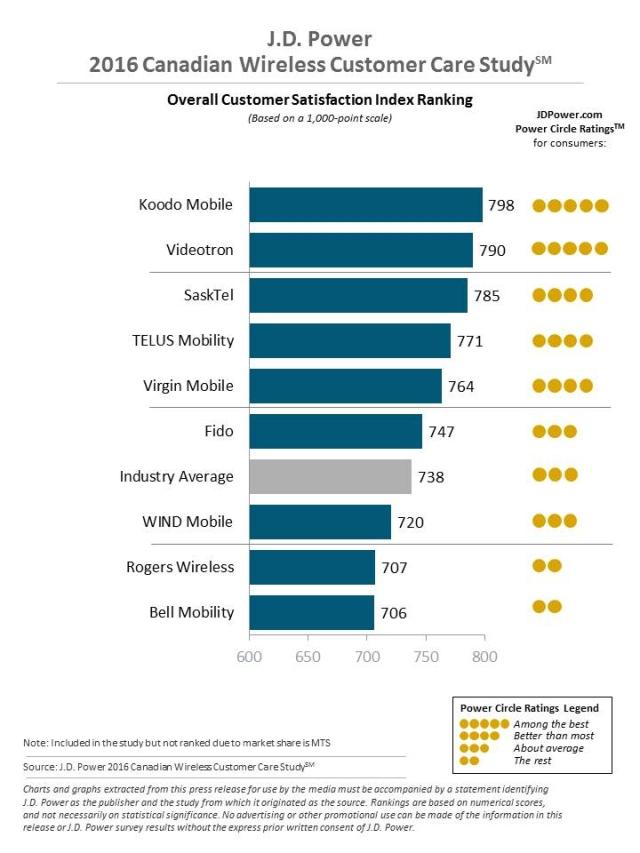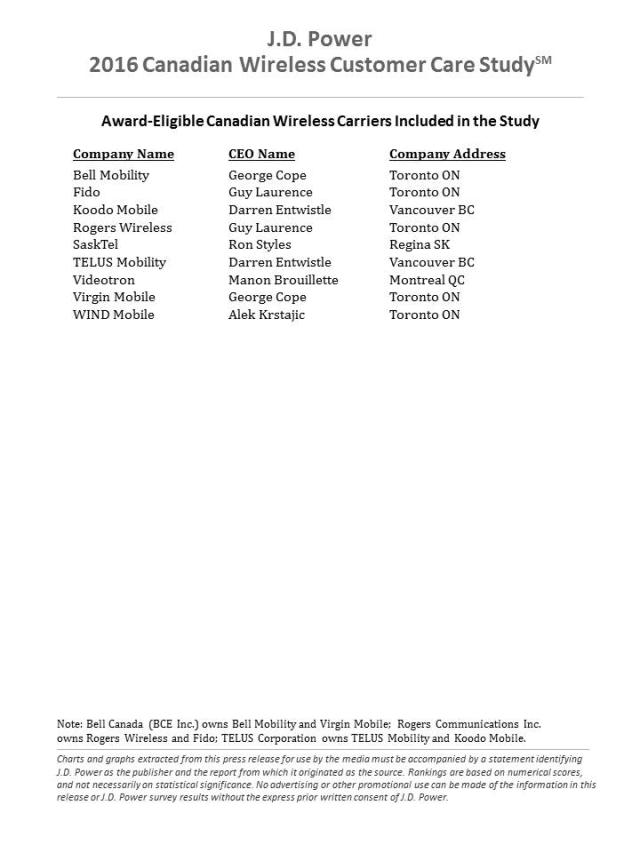Canadian Wireless Customers Take Charge with Self-Service Online Tools for Problem Resolution; Satisfaction Rises, Says J.D. Power Study
Koodo Mobile Ranks Highest in Satisfaction with Customer Care
TORONTO: 28 April 2016 — Wireless customers in Canada, notably Millennials (born 1982-1994), are increasingly taking a hands-on approach to resolving issues with their carrier by contacting customer service online and using chat tools, a shift in customer care preferences that has helped improve satisfaction, according to the J.D. Power 2016 Canadian Wireless Customer Care Study,SM released today.
The study measures wireless customers’ perceptions of their carrier’s performance in the estimated $22 billion[1] wireless market. Satisfaction is measured across four factors (listed in order of importance): phone customer service representative (CSR); in-store service; online service; and phone automated response system (ARS). In 2016, overall wireless customer care satisfaction rises to 738 from 715 in 2015 on a 1,000-point scale.
Online Service Tools Surpass Traditional Phone
As wireless carriers face a maturing and potentially saturated market, customer service differentiation continues to be top of mind. According to the study, wireless customers are moving away from traditional phone contacts and instead adopting a self-service approach to resolving issues with their carrier by using online tools as their go-to method for contacting customer care. One-third (33%) of care contacts are conducted online (including carrier website and chat function), a sizeable increase from 28% in 2015. In terms of contact frequency, the online channel now surpasses each phone channel (ARS; ARS, then CSR; and CSR only).
Millennials Prefer to Self-Serve, Others Likely to Follow
The migration toward online channels is being driven by Millennials’ preference for self-service, which allows them to deal with issues whenever it’s convenient for them. Millennials, often digitally connected, are much more likely to have had a contact in a self-service-enabled channel than customers in the other generations. Four in ten (40%) Millennials contacted customer care online during the previous 6 months, compared with 29% of other customers. Millennials also show their preference for self-service by using the ARS only channel at a much higher rate than other customers (14% vs. 6%, respectively). Among Millennials who contact their carrier online, the incidence of those who use the chat feature has risen considerably from 2015 (51% vs. 45%, respectively) as has the rate of visiting a user forum (19% vs. 14%).
“Wireless carriers need to embrace the shift to online self-service across all customer segments to provide a gratifying experience that matches customer behaviours,” said Adrian Chung, director at J.D. Power.“While Millennials have initially led the migration, customers across all generational groups are also being exposed to self-service tools with companies outside of telecom to resolve customer service issues in a timely and efficient manner. The task for carriers is to create awareness, educate customers and communicate the benefits of using these digital channels.”
Millennials Contact Customer Care Twice as Often as Boomers
Millennials contact customer service with relatively high frequency. As they become a larger share of the customer base, customer service becomes an increasingly important aspect of the overall customer experience. In Canada, Millennials made an average of 4.9 customer care contacts during the previous 6 months, compared with 2.5 contacts made by Boomers (born 1946-1964). A similar finding is reported in the J.D. Power Millennials Insight Report: The Customer Experience PerspectiveSM released in the United States earlier this year. Among U.S. wireless customers, Millennials are also frequent users, having made an average of 1.7 care contacts in a 3-month period, compared with 0.5 contacts made by Boomers.
Following are some additional findings of the 2016 study:
- Efficient Problem Resolution Impacts Satisfaction: For customers using the online channel, there is a 220-point gap in satisfaction between customers whose most recent question was answered online and those whose question was not (760 vs. 540, respectively). This key performance indicator (KPI) is met 80% of the time.
- Time Matters in Problem Resolution: Satisfaction is 830 when it takes less than 5 minutes to resolve a problem online, compared with 677 when it takes 10 minutes or more for resolution—a 153-point difference. Satisfaction is also impacted when more Web pages must be viewed to resolve an issue (780 for one page vs. 654 for four or more pages).
- Satisfaction Influences Customer Loyalty: On average, 47% of delighted customers (overall satisfaction scores of 900 or higher) say they "definitely will not" switch to another carrier, while just 12% of displeased customers (scores of 549 or lower) say the same.
Wireless Carrier Rankings
Koodo Mobile ranks highest in customer care satisfaction with a score of 798. Koodo Mobile performs particularly well in the in-store service and online service factors. Videotron (790) ranks second, followed by SaskTel (785).
The 2016 Canadian Wireless Customer Care Study is based on responses from more than 5,500 wireless customers. The study was fielded in August – September 2015 (Wave 1) and March 2016 (Wave 2).
Media Relations Contacts
Gal Wilder, Cohn & Wolfe, Toronto, Canada; 647-259-3261, gal.wilder@cohnwolfe.ca
Jennifer McCarthy, Cohn & Wolfe, Toronto, Canada; 647-259-3305, jennifer.mccarthy@cohnwolfe.ca
John Tews, J.D. Power, Troy, Michigan; 248-680-6218, media.relations@jdpa.com
For information about the 2016 Canadian Wireless Customer Care Study, visit http://canada.jdpower.com/industry/telecom-ca
See the online press release at http://www.jdpower.com/press-releases/2016-canadian-wireless-customer-care-study
For more information about the Millennials Insight Report: The Customer Experience Perspective, visit http://www.jdpower.com/Millennials
About J.D. Power and Advertising/Promotional Rules http://www.jdpower.com/about-us/press-release-info
[1] Source: Canadian Radio-television and Telecommunications Commission http://www.crtc.gc.ca/eng/publications/reports/policymonitoring/2015/cmr5.htm

